Resonances.......fritz mueller
Resonances | ||
Copyright © 2012 Fritz Mueller |
Resonances and Chladni PatternsGuitars, like other musical instruments, display several distinct resonances that are important determinants in the sound of the instrument. These resonances occur at a range of frequencies and, interestingly, have unique shapes that usually appear in a predictable pattern as one progresses from low to high frequency (or low to high notes, to use musical terminology). The behavior of the resonances is complex and is not especially well understood by physicists, particularly in regard to the question of what makes a great guitar. Nevertheless, I have found resonances to be a very useful tool for improving and giving consistency to my instruments. Dealing with wolf notes, dead notes, and issues such as balance, power, and timbre, plus many others, are all made much easier with a knowledge of resonances. For centuries luthiers have tapped wood with their knuckles to learn the pitch (or frequency) of the resonances involved, and that method, involving hands and ears and musical judgment, is unlikely to ever be replaced. However, it is also very helpful if the builder can see the shape of a resonance as well as hear it, and for that other methods are available. Physicists use holography and other sophisticated techniques to see the resonances, but in the working guitar shop, a simple and very effective method is the creation of resonance patterns using a sound generator, a speaker, and tea leaves. These resonance patterns or modes are often called Chladni patterns, named for the German physicist, Ernst Chladni, who first developed the technique in the nineteenth century. |
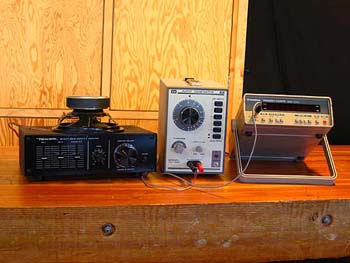 Here is the equipment I use in my shop to create Chladni patterns. Only the tea leaves are missing! 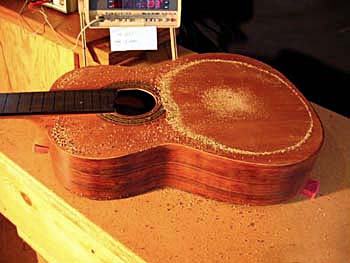 The tea leaves vibrate to non-moving areas of the top (called nodes). This is the fundamental resonance of a recent guitar, and its frequency shows on the counter. At 193 hertz (cycles per second) it is very close to the frequency of G3. 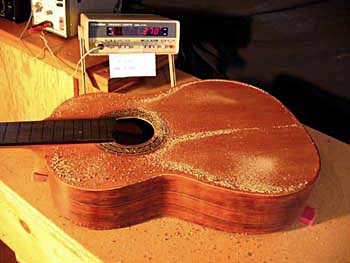 Here are a few other resonances of the same guitar. You can see how the patterns change as the frequency rises. This is 270 hertz. 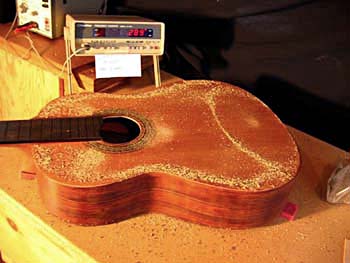 |
289 hertz. |
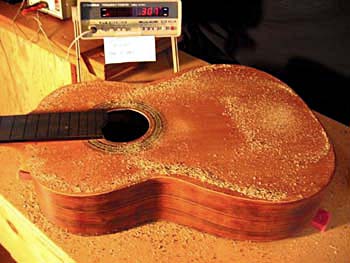 |
307 hertz. |
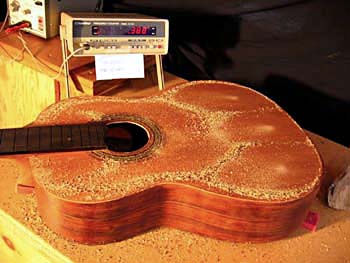 |
388 hertz. |
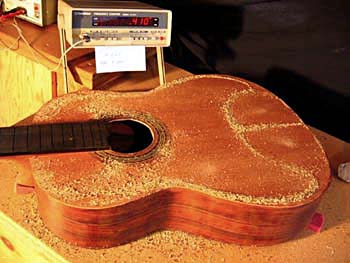 |
410 hertz. |
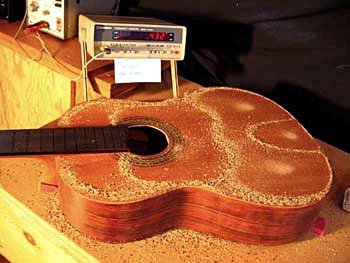 |
432 hertz. |
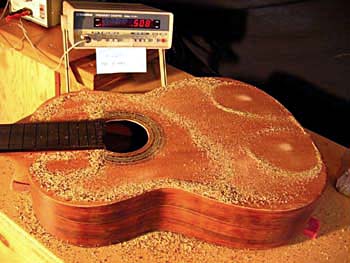 |
508 hertz. |
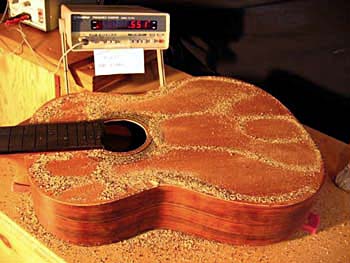 |
551 hertz. |
So how do the resonances, as heard with a tap of a knuckle or seen in a Chladni pattern, relate to the musical qualities of the instrument? At a resonance a guitar is vibrating very efficiently, which means that the notes whose frequencies are near that resonance are strong and easy to produce. When you play along the strings on most guitars, you notice that some notes are slightly louder, with a faster attack and better definition. These notes are being supported by a resonance. Conversely, the notes that are quiet and sluggish (or even dead) probably don’t have a resonance nearby to help them. In order to achieve balance and evenness, the luthier’s task is to disperse the resonances so that they can support notes everywhere on the fingerboard, from the lowest bass notes all the way up to the highest frets on the 1st string. If the goal is to have a stronger treble, then the luthier tries to have more and/or stronger resonances occur at higher frequencies. And if a more powerful bass is the objective, then the resonances at lower frequencies are emphasized. Part of the challenge for the luthier is to locate the frequencies of the resonances close to those of the notes to be supported, but not at exactly the same pitch. Wolf notes are examples of notes that are supported too closely by a resonance. At the particular pitch of the wolf note, the resonance is allowing the guitar to work so easily that the sound is loud and honky. The solution is to move the resonance away from the note; sometimes a distance of only a few hertz is adequate. The fundamental (or lowest) resonances of the top and back are important factors in the basic tonality of the guitar. In actuality, the physics of the guitar are so complex and so little understood that setting the resonances of the top and back plates at particular frequencies can only be an approximation – a form of shorthand – for all that is really happening. Nevertheless, these resonances do seem to determine qualities inherent in the character of the instrument. Show an experienced player a guitar with fundamental resonances set high (or low) and the comment is likely to be: “Nice, but it doesn’t really sound like a classical guitar.” The fundamental resonances of the tops of the Hauser guitars that I have examined range from F# (185 hertz) to G (196 hertz). It is my understanding that Segovia’s famous Hauser (which I have not examined) also has a top resonance near G, and for many years I have taken this as a target for my own work. Segovia’s Hauser also apparently has a back resonance near A (220 hertz), which corresponds with my own research on other Hauser instruments, and which I use as a target resonance for the back. Initially, of course, I used these targets on traditionally-built, solid top instruments. Now I use them to give my double-top guitars the familiar, beautiful classical guitar tonality. In the future I hope to enlarge this discussion of resonances, but because the topic is probably of interest only to builders and technically-minded players, I plan to put it in a separate section of my website. I welcome correspondence from both players and builders about the subject. |
Articles
- 이기타에 대해 아시는분 있나요?4
- Making a Guitar | Handcrafted Woodworking | Où se trouve: Greenfield Guitars
- Documental de la construcción artesanal de las guitarras Francisco Bros.
- 넥 휨 볼때,2
-
 Koh Jeongseock No.182
Koh Jeongseock No.182
- 기타 구입 조언부탁드려요..3
-
 강화도 수님 공방 기타제작.
강화도 수님 공방 기타제작.
-
 Koh Jeongseock No.173
Koh Jeongseock No.173
-
 현대기타 디자인
현대기타 디자인
-
 기타, 그 모든 것1
기타, 그 모든 것1
-
 최동수 작 비웰라형 기타9
최동수 작 비웰라형 기타9
-
 5 Famous Torres Guitars2
5 Famous Torres Guitars2
-
 Torres guitar2
Torres guitar2
- Torres FE-17 copy guitar trilogy by Michael Thames2
- Daniel Friederich, Luthier - 5 Minute Trailer3
-
 최동수 제작가님 최근 제작기!1
최동수 제작가님 최근 제작기!1
- 그라나다 기타제작
- 공지......기타이야기 게시판은요
- 쉘락 휘니시... french polish of shellac
- 눈메 메꾸기..에폭시
- Smaro Gregoriadou and her Guitar
- nut position
- 와그너와의 대담.
- 손톱5
-
 case bam5
case bam5
-
 꿈은 이루어진다.5
꿈은 이루어진다.5
-
 최동수 제작가님 최근 작품!4
최동수 제작가님 최근 작품!4
-
 기타평가의 기준. ... 프리드리히.
기타평가의 기준. ... 프리드리히.
- 리라 기타에 대하여10
-
 세고비아의 라미레즈6
세고비아의 라미레즈6
-
 Herman Hauser 1세1
Herman Hauser 1세1
-
 최동수선생님 4번째 리라기타 제작기
최동수선생님 4번째 리라기타 제작기
- Pablo Villegas 의 기타6
-
 Koh Jeongseock No. 78
Koh Jeongseock No. 78
- 목재정보
-
 쌍둥이 리라 기타9
쌍둥이 리라 기타9
- 그라나다 기타계보
-
 최동수선생님 류트 기타 제작기!11
최동수선생님 류트 기타 제작기!11
- 화성학과 애드립을 위한 교재!
- Alma guitar 김희홍 KBS 문화현장3
- Andrea Tacchi 기타제작 동영상
-
 Koh Jeongseock No. 66
Koh Jeongseock No. 66
- 통기타 리뷰 진짜 제대로 해주네요
- 기타현에 대한 글
- Build a Guitar 비디오
-
 최동수선생님 최근 제작 악기 소개3
최동수선생님 최근 제작 악기 소개3
- Regis Bonilha - Luthier
- 마사키 사쿠라이 다큐멘터리1
- 마누엘 벨라스케즈 다큐멘터리1
- 류트 공방에서의 영상
- 플라멩꼬 기타 제작
- granada school
- 부산국제악기제작가페스티벌 PT 동영상 자료
-
 스피커 기타8
스피커 기타8
-
 기타 구경하세요 -25
기타 구경하세요 -25
-
 기타 구경하세요-13
기타 구경하세요-13
- 로만일료스 동영상2
-
 하카란다2
하카란다2
- 고딘VS야마하사일런트 비교 영상 링크~1
-
 1962 Classical guitar by Robert Bouchet_Brompton's 경매회사4
1962 Classical guitar by Robert Bouchet_Brompton's 경매회사4
- 라미레즈 기타에 대하여22
-
 특이한 디자인 기타 (최동수선생님 봐주세요 ㅎ)7
특이한 디자인 기타 (최동수선생님 봐주세요 ㅎ)7
-
 최동수님 2013년 9월에 완성될기타 훔쳐보기....21
최동수님 2013년 9월에 완성될기타 훔쳐보기....21
- Razon 프렛 계산방식
- 기타현의 장력 비교.1
-
 Resonances.......fritz mueller1
Resonances.......fritz mueller1
- 기타 명기(名器)와 명장(名匠)들 2권1
- <나의 음악 이야기>-페이스북 연재-섬소년
- 기타 전문잡지 오르페오 창간호7
- 라미레즈-통념과 사실2
-
 리사이틀 박스7
리사이틀 박스7
-
 태평양 건너온 귀한물건 입니다.3
태평양 건너온 귀한물건 입니다.3
-
 최동수선생님 악기 탐방!5
최동수선생님 악기 탐방!5
-
 슈퍼칩(string tie)7
슈퍼칩(string tie)7
- 대전 국제기타페스티벌 기타전시회 관람기1
- 스페인 제작자2
-
 재미있는 기타 입니다....3
재미있는 기타 입니다....3
-
 에르고 플레이 고무압착기 오래 쓰는 방법2
에르고 플레이 고무압착기 오래 쓰는 방법2
- 황칠2
-
 최동수 선생님이 만드신 지팽이 기타.....9
최동수 선생님이 만드신 지팽이 기타.....9
-
 최동수 선생님이 새로 만드신 총 기타...18
최동수 선생님이 새로 만드신 총 기타...18
-
 세계적인 기타제작가 액자 전달식1
세계적인 기타제작가 액자 전달식1
- 왜 4번줄만 끊어지는가?8
- 사운드홀의 비밀15
- 기타의 공명은 제갈공명인가?5
- 기타와 초음파진단기8
- 공명은 음을 확대하는가?7
- 실험정신(공명)7
-
 특별한 기타.....음향반사판기타39
특별한 기타.....음향반사판기타39
-
 클래식기타 컬렉션 20081
클래식기타 컬렉션 20081
- 현장이 짧은 기타에 대하여-25
- 현장이 짧은 기타에 대하여-17
-
 헬름홀츠의 공기공명1
헬름홀츠의 공기공명1
-
 발 받침대 한컷4
발 받침대 한컷4
- 오일바니쉬...4
-
 기타 모델링2
기타 모델링2
- 스트링 게이지와 음정 관계
- 기타의 성능 (jeffrey elliot)1
- 책 안내 - "기타 명기와 명장"
-
 간단한 댐핏 만들기13
간단한 댐핏 만들기13
Designed by sketchbooks.co.kr / sketchbook5 board skin
Sketchbook5, 스케치북5
Sketchbook5, 스케치북5
Sketchbook5, 스케치북5
Sketchbook5, 스케치북5